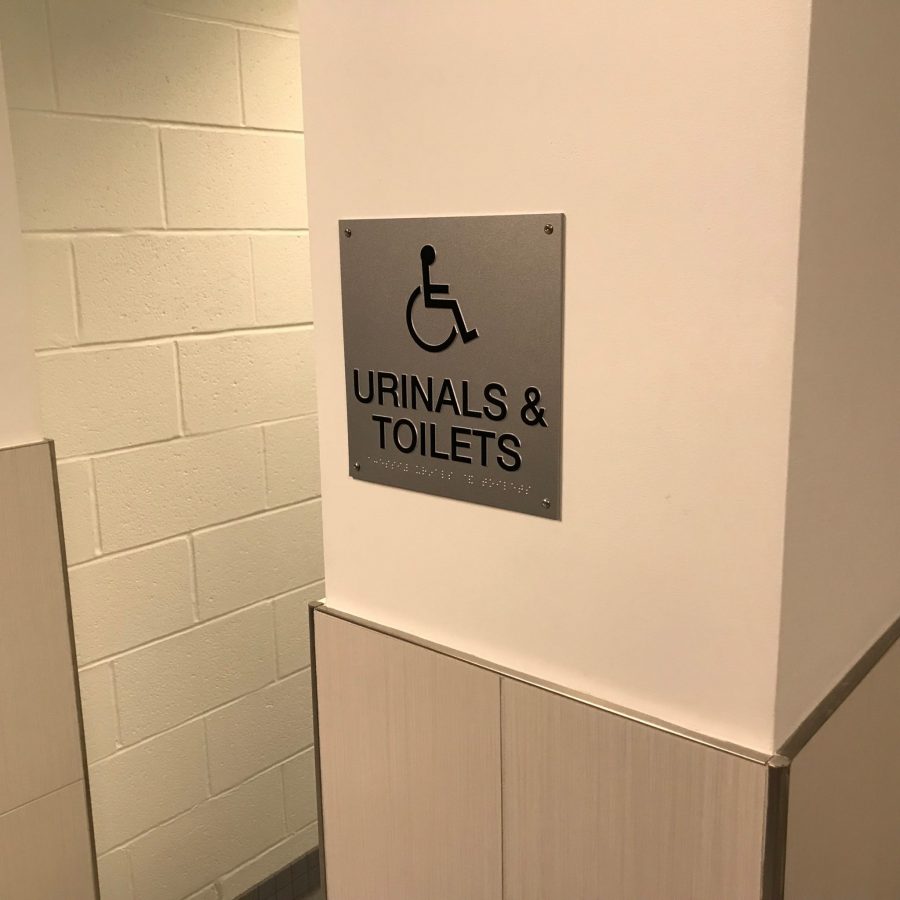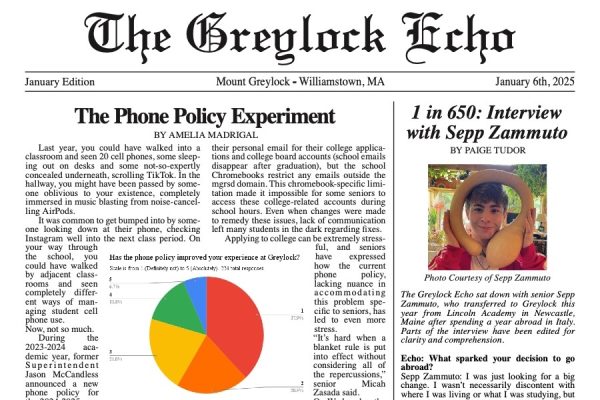Signage Conversation Continues at Student Forum
Photo courtesy of Owen Tucker-Smith
One of the new bathroom signs on the first floor.
Editor’s note: “Students Express Concern Over Bathroom Signage,” the article which this forum was a response to, was published in the November 16 print issue of the Echo. You can read this article, as well as the rest of this print issue, here.
On Tuesday, November 20, Principal Mary MacDonald held a public forum for interested students about bathroom signage at Mt. Greylock. The forum acted as MacDonald’s response to sentiments expressed in an Echo article published the Friday beforehand. The civil discourse that took place took up much more than the allotted time, a testament to the willingness on both sides to share concerns.
According to MacDonald, the purpose of the forum was for her to become informed of students’ concerns and for students to be able to ask any questions they had. After giving a brief speech outlining what the forum was meant to accomplish, she opened the floor to questions. Owen Tucker-Smith, the Echo’s editor-in-chief, brought up the first point in the meeting. Tucker-Smith mentioned the misquote on the part of the Echo in the November 16 article which implied that GSA’s Sophie Jones “pioneered” the change, when the idea actually originated within subcommittees working with the administration that helped decide many aspects of the building’s construction, including signage. The GSA played a large role in the discussion, but they were not at the center of the initial idea.
MacDonald expanded on this, talking about how the idea came into play at all. She explained that “we were seeing a lot of changes with regard to single person bathrooms and it started there … In the old school it said men’s and women’s and we wanted to rethink that, because that wasn’t the direction we wanted to go in, and then as we were talking about that, we threw out ‘well, what about the larger group bathroom? How do we talk about those? How do we think about labeling them?’”
She continued to describe the origin of the “purpose-driven bathrooms,” as well as the reason that locker rooms did not have the same purpose-driven labels: “one of the members [of the interior design subcommittee] had done some research and got this idea of a purpose-driven bathroom, so we decided to move in that direction for the large group bathrooms… we thought about that for the locker rooms, and then in the end, after much discussion, especially since the locker rooms were spaces that were used by many people who were outside of our community, we decided that at this point, it was better to stay with gender-specific, like, boys’ locker rooms and girls’ locker rooms.”
With a brief overview of the origins and reasoning behind the purpose-driven bathrooms established, senior Jakin Miller opened the forum with the first question, asking, “what was the driving force behind [moving away from men’s and women’s bathrooms] in addition to the gender neutral bathrooms?” MacDonald once again reaffirmed that she “wanted to move away from having a specific gender label,” and that the main goal was describing the contents of the room as opposed to the aforementioned gender-based labels. She further mentioned the legal consideration administration had when it came to the bathrooms: “in Massachusetts… the law is that you can use the bathroom that you wish to use, and that’s been something that’s very clear at Mt. Greylock.”
Miller then moved to the heart of the issue as described by most students, wondering “why is it better to label them like this and say ‘we expect boys to use this one and girls to use this one’ as opposed to labeling it ‘boys’ and ‘girls’ and saying ‘anyone can use it, because that’s the law?’” MacDonald, after mentioning a slight issue with terminology (the word “anticipates” versus the word “expects,” and that “expects” has a seemingly harsher connotation), continually re-established that the main idea was simply to find a way to divide the gang bathrooms without “ascribing gender to it.” Another repeated motif was the mentioning of universities’ bathroom policies, with the gender neutrality of many college bathrooms brought up as an example of what the Mt. Greylock community is currently taking small steps toward with the lack of binary labels on signage.
Senior Katrina Hotaling expanded on Miller’s points, saying that the association of ability to use a urinal or a toilet (i.e. genitalia) to gender is a less desirable direction to go in. She further expressed her concern over the language used to describe the bathrooms, and the gender-neutral bathrooms especially, saying that “the way the neutral bathrooms were talked about to students was that we were told that unless there was a special reason for students to be using them, they shouldn’t be using those bathrooms… if somebody were to use those bathrooms, it would be outing them to people.” MacDonald said that “the individual bathrooms are first and foremost designed for the adults in the building and adults who come into the building who don’t work here. And the reason I say that is because generally, especially in the climate that we live in now, I think it’s a wise decision to try to separate the adults from the students… the individual bathrooms were designed for the adults, but we’ve had kids who have used the individual bathrooms for all sorts of reasons for years that had nothing to do with gender identity… typically, we generally knew why they needed them, but to my knowledge, nobody has been chastised for using an individual bathroom.” Mrs. Pardalis-Johnson and MacDonald also brought up some certain issues with letting kids use the individual bathrooms, and some reasons why it had not necessarily been encouraged among students: the possibilities of vaping, inappropriate interpersonal activity, and eating, for example. The general consensus was that, while using the individual bathrooms is by no means encouraged, it would not be specifically called out unless it was a particularly peculiar circumstance (e.g. a student staying in there for an unnecessarily long period of time).
One student, in response to the statements about individual bathrooms, brought up the prospect of having multi-stall gender-neutral bathrooms. In response to MacDonald’s belief that the community was not ready for that kind of step, they commented that “the community wasn’t really given the option to be ready,” a statement that earned nods and agreement from surrounding students. MacDonald replied by saying that, being a regional school, it would be difficult to coordinate all viewpoints on the issue with such a wide spectrum of opinions in the mix.
Various students vocalized their opinions as discussion moved around the circle: senior Karen McComish noted that, while architecture could not be changed, the language used to talk about the signage could. Senior Theo Sandstrom added that “you may as well just revert back to men’s and women’s rooms if people are just expected to use the bathroom that they identify with… if you’re reading into the purpose-driven, it ties you to your biological sex.”
Jakin Miller brought up another issue, which was confusion on the parts of outsiders who don’t necessarily understand the new signage. “We had a cross country meet here, and the Lenox boys walked in and only saw the toilets room and thought it was gonna go to, like, a passage to a boys’ and girls’ bathroom and walked in, and that’s happened before and I’ve heard about parents at sporting events only seeing one bathroom… because most of them are right next to each other, but the ones right next to the gym, there’s kind of a water fountain in between… and if you’re not looking for it, like if I saw ‘toilets’ with a passage there, I would think it was gonna go to two different… like a hallway with two different [bathrooms]. I think that’s the other problem,” said Miller.
According to MacDonald, groups talked to about signage included “parents, teachers, and a couple of community members, people mostly from Williamstown and Lanesborough, as well as our architects and designers.” She mentioned that students were consulted about furniture and other such matters but not necessarily the new signs.
McComish, in the last student statement of the forum, expressed her gratitude on behalf of all of the students for the ability to have a constructive and civil conversation with a member of administration on the controversy.
At the end of the forum, MacDonald said that “this is lots of information… Signs are signs, it’s expensive to take out a urinal, it’s not so expensive to take out a sign… I don’t think we’re going to be without continued pushback in both directions, and I think this was a great, civil conversation. The other thing I want to say is thank you for coming here, because this is a face to face conversation, and I can hear what you have to say, and that’s so important.”
Owen has been on Echo staff for three years. When not writing, editing, and publishing stories, he can be found doing nerdy things (playing the piano, participating in Model UN), stupid things (skiing up hills - apparently that's a thing?), and productive things (watching Greys Anatomy). He loves editing the Echo because pestering other people about deadlines is his specialty.







